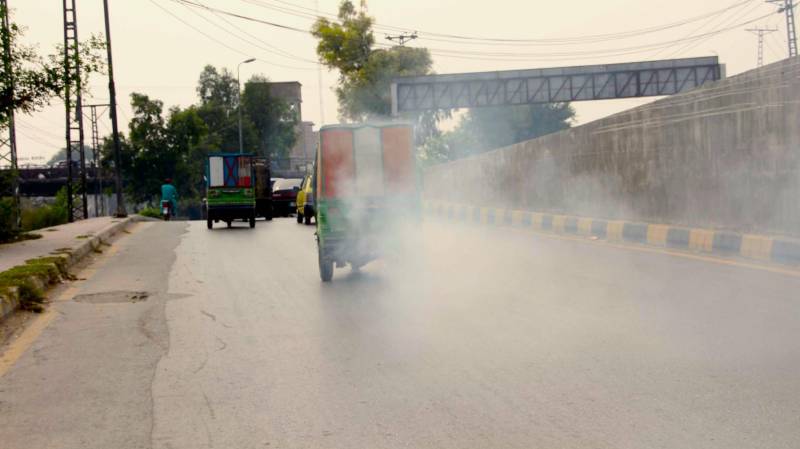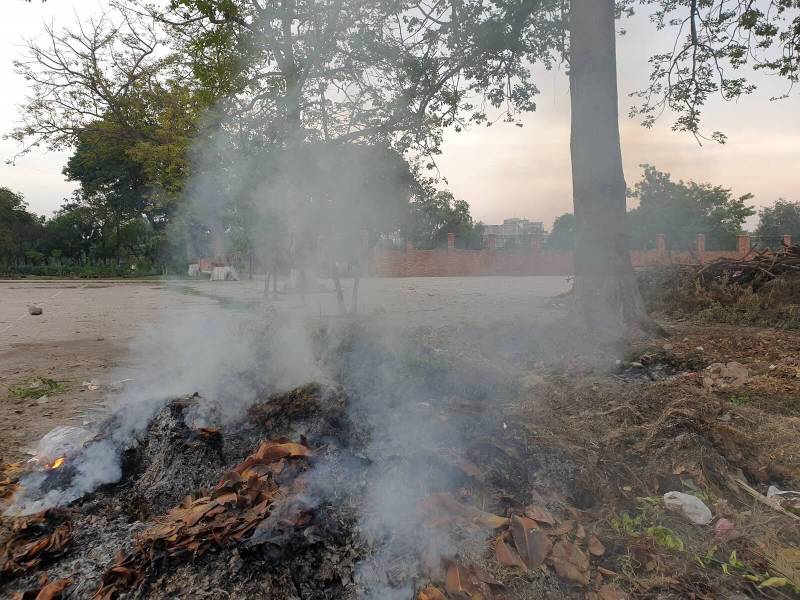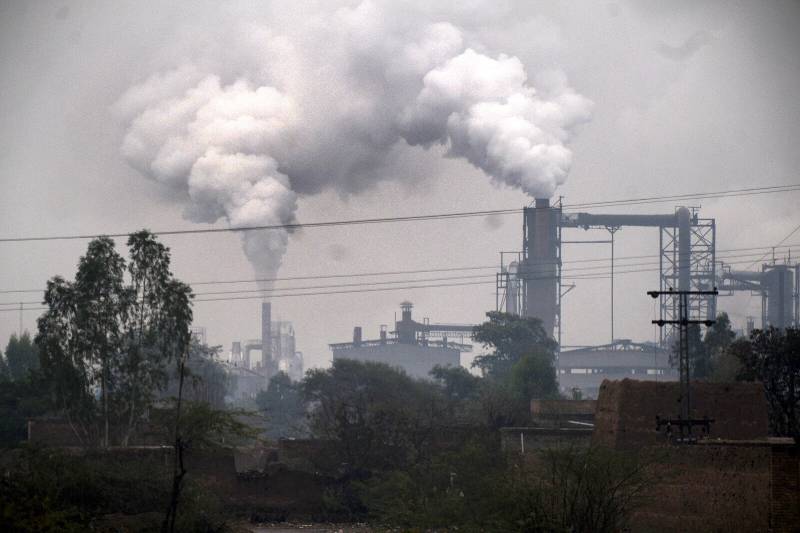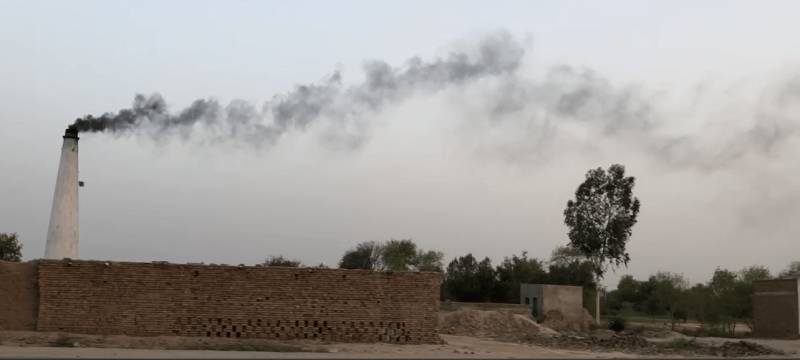
When one mentions the historic northwestern city of Peshawar, thoughts circle to chilly winter evenings, warm cups of tea and shawls draped over shoulders, sitting in circles telling stories of near and far, of romance, mystery and adventure while breathing in the crisp air of the "City of Flowers". Even those who have never had the chance to walk through the narrow lanes of Qissa Khwani Bazaar immediately associate the city with the popular Pashto song "Lar Sha Pekhawar ta Qamees Tor Mala Rawara…Taza Taza Gulona Dri Salor Mala Rawara" (Go to Peshawar and bring me a black shirt, and four fresh flowers). But of late, this city of flowers - an ode to the freshness of the air full of scents from colourful flowers - has been choking from the pungent and acrid smoke emitted by cars, industries and brick kilns.
Among the oldest cities in the subcontinent, the cityscape has undergone rapid transformation in recent years with a fast-multiplying population, horizontally spreading urban sprawl connected with blacktop roads, a fancy new bus system, and arguably as many vehicles as people. But this step into modernity has come at a great cost for Peshawar, with Pakistan's sixth largest city by population suffocating, and a recent report deemed it the fourth most polluted regional city.
The city of flowers is now a city of smoke and pollution slowly but surely killing its inhabitants.
Peshawar has an air problem
The capital of Khyber Pakhtunkhwa (KP) has swelled to 4.76 million in 2023, up from 4.33 million in 2017. Not only has this period seen an increase in Peshawar's population, but the construction of highways linking places such as Swat, Dir and Chitral, apart from improved roads leading to the frontier regions of Khyber, Mohmand and Waziristan, have further reinforced Peshawar's longstanding identity as a trade centre and a hub - not just for people from across KP and those coming from other provinces and regions, but also from visitors from across the border in Afghanistan.
This contributes to increased traffic on the roads of Peshawar of all sizes. Then, the rapid development of industrial zones around Peshawar and the need for brick kilns to support the construction boom.
The cumulative impact of their emissions is now visible in the city. An air quality report from October 19 last week showed that the air was unhealthy that day. This conclusion was based on high readings for PM2.5 (Particulate Matter suspended in the air that is larger than 25 microns -- around 30 times smaller than a human hair but still can easily affect the human respiratory system).
It reinforced the World Air Quality Report for 2022 by IQAir, which determined that the mean air quality in Peshawar was so poor that it ensured it was listed as the fourth most polluted regional city.
Air pollution kills
The World Health Organisation (WHO) estimates that air pollution is among the leading environmental factors contributing to poor public health. It is also listed as a major cause, leading to about seven million premature deaths yearly due to consequential respiratory and circulatory illnesses.
With many regions of Pakistan consistently reporting high levels of fine particulate air pollution (PM2.5), the average life expectancy of residents is reduced by 3.9 years.
For residents of areas facing very high levels of air pollution consistently, such as Lahore, Peshawar, Sheikhupura and Kasur, lives could be shortened by as much as seven years.
The impacts of the poor air in Peshawar are already visible on the ground.
The Lady Reading Hospital (LRH), a major hospital in Peshawar and KP, has reported a steady increase in patients complaining of respiratory diseases.
LRH Spokesperson Muhammad Asim told The Friday Times that respiratory disease patients usually increase in winter. With Peshawar at the cusp of winter, Asim said that the hospital's pulmonology ward (which treats respiratory diseases) is facing a busy period, treating around 300 patients daily.
He expected this number to rise to 500 during the peak of winter.
Dr Anila Basit, an associate professor at the Pulmonology Department of LRH, told The Friday Times that air pollution impacts in Pakistan are higher than those witnessed in other developing countries. Dr Basit attributed the higher incidence of respiratory diseases to worsening air quality. As evidence of her theory, she pointed to how certain symptoms and diseases such as shortness of breath, allergic reactions, chest allergies, Allergic rhinitis (allergic flu), and asthma are becoming more and more common.
She said the average PM2.5 concentration in Pakistan is currently 11.8 times above the WHO's recommended air quality levels.
Sounding an alarm, she said that children are far more vulnerable than adults and thus at risk from the environmental impact of bad air quality.
Tracing causes of air pollution in Peshawar
In a city where the average life span has been shortened by several years, it is imperative to trace the factors contributing most to air pollution in the city.
A recent report produced by the Peshawar Clean Air Alliance (PCAA), with support from the SEED Programme on the status of air pollution in Peshawar, found that contrary to expectations, vehicles plying on the roads were the biggest contributors to air pollution.
From two-wheeler motorbikes up to 18-wheeler trucks, they contribute around 58.46% of air pollution in Peshawar. It was followed by dust and re-suspended dust (17.67%), the domestic sector (11.66%), industry (6.58%), open waste-burning (4.10%), and lastly, the commercial sector (1.49%).
KP's Regional Transport Authority (RTA), which regulates the legal operation of commercial vehicles, told The Friday Times that there are approximately 39,000 registered rickshaws with active 25,280 route permits which scurry about Peshawar daily.
Moreover, since Peshawar is a major trading node, there are some 39,717 registered loader vehicles, including trucks, pickup vans (known as Suzuki based on the company name), and larger cargo flatbed vans (known as Shehzore based on the company brand name), which hold route permits.
Similarly, some 6,783 registered taxis/cabs and 15,700 passenger vans (known as Hi-ace based on the company brand name) exist.
RTA officials told The Friday Times that around 20 percent of the vehicles operating in the public transport sphere are over 20 years old and were manufactured in the 1990s. They added that they have stopped issuing and renewing permits for vehicles over 30 years old or those manufactured in 1990 or prior.
The RTA cautioned that it could not present a definitive picture of the number of vehicles plying on the roads of Peshawar as it does not register all the vehicles operating in the district -- private passenger vehicles, nor does the excise department, since a lot of vehicles which have not been registered in Peshawar are plying on the city's roads.
When The Friday Times contacted the Excise Department in Peshawar - which maintains data on all vehicles registered in the province - it refused to share specific data.
However, a 2019 report estimated the number of vehicles plying in Peshawar without registration or permits stood at 80,000.
Khyber Pakhtunkhwa Environmental Protection Agency (KP-EPA) is the prime public body responsible for regulating and controlling pollution in the province by implementing the KP EPA Act 2014.
But the EPA is beset with many challenges in fully implementing the law, least of all resources. One example is that the EPA is currently relying on air quality data recorded by the US Consulate in Peshawar. The EPA's sole air monitor has been deemed out of order for the past three years, with no repairs affected yet.
While the act covers pollution and other related areas and sectors, the agency has focused on large industries around Peshawar.
The industries, though, only contribute just 6.58% of the city's air pollution and point to the transport department to regulate vehicular emissions through the Vehicular Emission Testing Services (VETS), which issues "fitness certificates" to vehicles annually.
When approached, the KP VETS told The Friday Times that they were duly monitoring and regulating vehicles for excessive emissions, particularly rickshaws, notorious for leaving a dense trail of white smoke in their wake.
KP VETS officials disclosed that during September 2023, their teams checked some 11,000 vehicles. Moreover, last year, the department had checked some 110,000 vehicles. Of these, they said, some 29,000 were fined by the traffic police for emitting smoke. When asked, officials said the maximum applicable fine for vehicles producing emissions was just Rs600. By current standards, the fine is worth two litres of fuel.
Despite claims from VETS, vehicles dating from the 80s and 90s continue to operate as public and passenger vehicles on the roads of Peshawar. Due to the immense wear and tear on their engines and the lack of proper emissions management systems on these cars, their emissions are significantly higher than vehicles manufactured more recently.
Various reports and environmental experts have pointed out that in recent years, vehicular emissions have overtaken emissions from other sources as the major cause of air pollution, at least in Pakistan.
In a recent seminar on "Green Industrialisation in Pakistan: Integrated Policy Strategy for Sustainable Future" hosted by the Social Protection Resource Center (SRPC) in Islamabad, LUMS Associate Professor Dr Syed M Hasan shared that the transportation sector in Pakistan is posing a policy challenge.
He said the transport sector, including private passenger and cargo vehicles, accounts for around 10% of the country's gross domestic product (GDP). In contrast, employment in the sector accounts for around six percent of total national employment. At the same time, it is responsible for 10% of the country's greenhouse emissions.
Data indicates, he said, that the total number of registered vehicles in the country swelled to 7,020,803 by December 2021. Later, while speaking to The Friday Times, Dr Hasan said these vehicles account for 25% of Pakistan's energy use and emissions. Citing the International Energy Agency (IEA), he said that from 2013 to 2018, Pakistan's transport sector emissions increased by 44% per capita.

BRT and a lost opportunity
When the Bus Rapid Transit (BRT) mass transit project was finally inaugurated in August 2020, the project which had cost Rs65 billion ($230 million) and took seven years to complete, it was hoped that more than just providing a mass transit solution for residents of the city, it would also help the government tackle the rising influx of privately owned vehicles. It was hoped that people would opt for the bus project instead of expensive public transport such as rickshaws or taxis, at least along the routes of the BRT project. Earlier this year, the BRT reported that some 74 million passengers used the BRT in 2022, with the bus service reaching peak daily usage of 270,000, of which just over a quarter, at 70,000, were women. The bus system, according to BRT authorities, saw 45%
But on the ground, no significant dent has been witnessed in the volume of vehicular traffic.
The only difference has been that the old public buses which ran from Karkhano market to Haji Camp Stop have reduced in numbers after the introduction of the BRT, but other mass transit vehicles continue to shuttle up and down this route daily, RTA officials told The Friday Times.
Peshawar's industrial pollution
While emissions from Peshawar's fledgling industrial estates do not compare to those from vehicles zipping across its streets daily, industries are the fourth largest emitters of air pollution, along with traditional brick kilns.

When the EPA took action against brick kilns, the Brick Kiln Association of KP moved the Peshawar High Court.
Last year, PHC gave a landmark decision in favour of the EPA and directed the EPA that if the association do not convert their traditional brick kilns to modern, emission-efficient 'zig-zag' system within a specified period, they must be sealed.
KP EPA Deputy Director Dr Habib Jan told The Friday Times that since the order, the EPA has tried to persuade the Brick Kilns Association members to convert their kilns to the zig-zag system to lower their polluting emissions. Moreover, Dr Jan said that they had offered training to these kilns, and in a scheme backed by an Annual Development Programme (ADP) scheme, some 200 stack-men/workers were trained.
However, the result of those efforts hashas been relatively miniscule, with only two of the 915 brick kilns in KP converting to the 'zig-zag' system.

As a consequence, Dr Jan said they will be taking action against the remaining 913 brick kilns soon with help from the local administration and police. In this regard, the EPA official said that they have sealed several brick kilns in different districts over non-compliance and will expand this operation soon.
On the topic of seasonal crop burnings, which contribute to poor air quality to the extent that the Lahore district in neighbouring Punjab suffocates, he said that the agency is coordinating with Town Municipal Administrations (TMAs) and Provincial Development Authorities (PDA) to stop the burning of crops at least along the roads to lower the risk of traffic accidents.
Air quality and winter effect
Dr Jan pointed out that with winter upon us, it was due to affect the quality of the city's air quality and that it will likely worsen during the winter months in Peshawar and many other places.
He explained that this is caused by several factors, including lower wind speeds during winter, lower humidity and more dryness in the air, temperature inversions - when a layer of warm air traps cooler air near the surface, causing pollutants emitted from various sources, such as vehicles, industries, agricultural residue burning, and residential heating, to get trapped close to the ground, leading to an accumulation of pollutants and hence poor air quality.
How to mitigate these effects
When asked, the EPA official said the initiatives for countering air pollution require significant investment in terms of finances and human resources, which can be a challenge for governments at every level.
What is attainable, however, is the introduction of inclusive and integrated policies and efforts. These include promoting and encouraging the use of public transportation systems, enhancing the capacity of VETS in Peshawar and other parts of the province, and promoting the use of electric vehicles as alternatives to high-emission vehicles.
He said that steps should be taken to enhance green spaces in the city, planting more trees, controlling industrial emissions, waste management, improving air quality monitoring, and environmental education and awareness amongst the public to mould public behaviour.
Dr Hasan added that one issue was that our policies relating to the transport sector have promoted the greater adoption of vehicles, from building roads to facilitate vehicular travel - whether passenger or cargo - to easy loans to acquire cars. As a result, he said that the number of roads has doubled while car financing has increased eight times in the past decade.
He suggested we shift our focus away from mass transit options such as railway networks, which now rely on government subsidies to survive.
Dr Hasan reminded that transportation remains a complex area in Pakistan with many stakeholders, from the federal to the local governments.
Despite that, he noted that the government has introduced policies to tackle emissions under the Transport Policy of 2018 and the National Clear Air Policy (NCAP). Under the NCAP, he said, one of the stated objectives was to reduce PM2.5 emissions by 38% by 2030 compared to the baseline scenario and by 21% compared to 2020.
But the government, he said, failed to provide an implementation framework or timeline for these policies.
He pointed out that Pakistan is a signatory to international treaties related to climate change. At the same time, it made commitments under the National Determined Contribution (NDCs) and the United Nations Sustainable Development Goals (SDGs) to lower emissions by 2030. But these require concrete steps and a dynamic approach to control air pollution.

